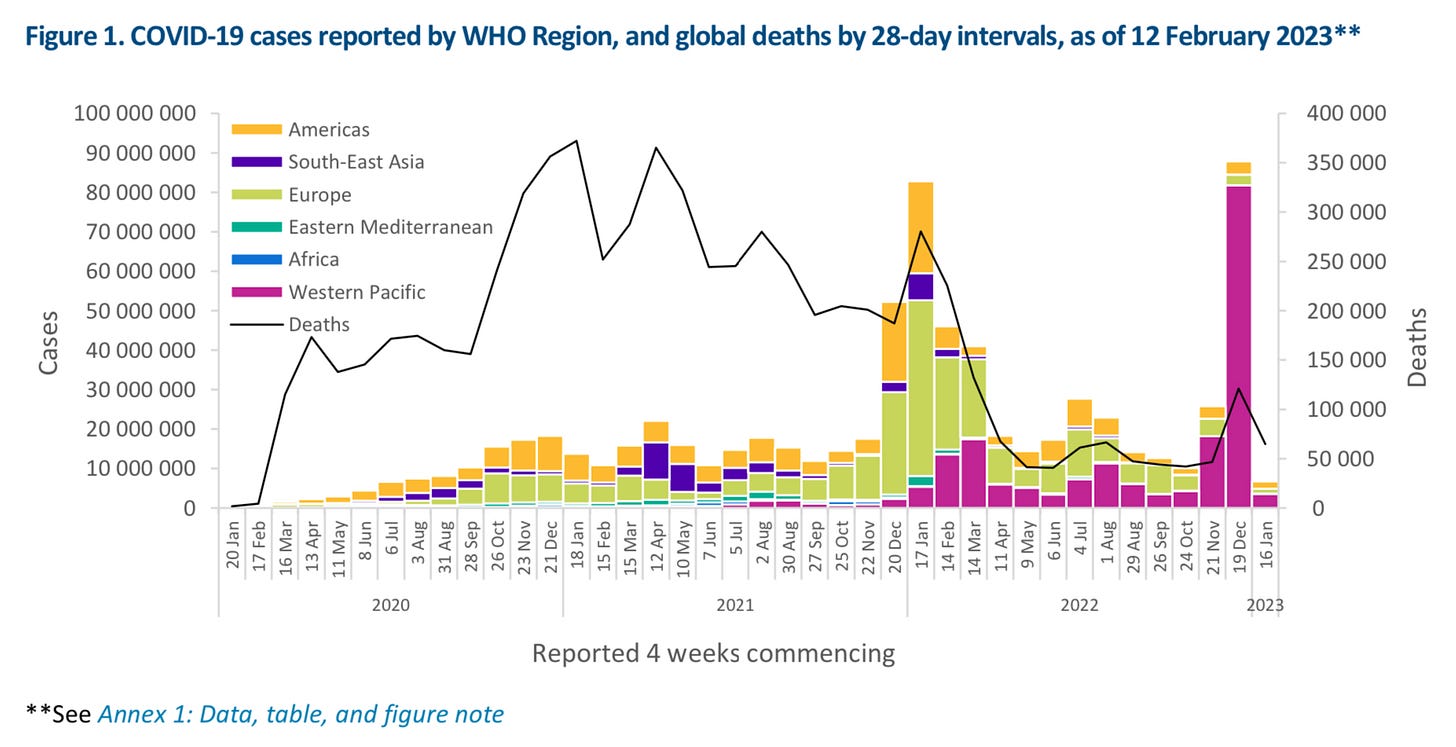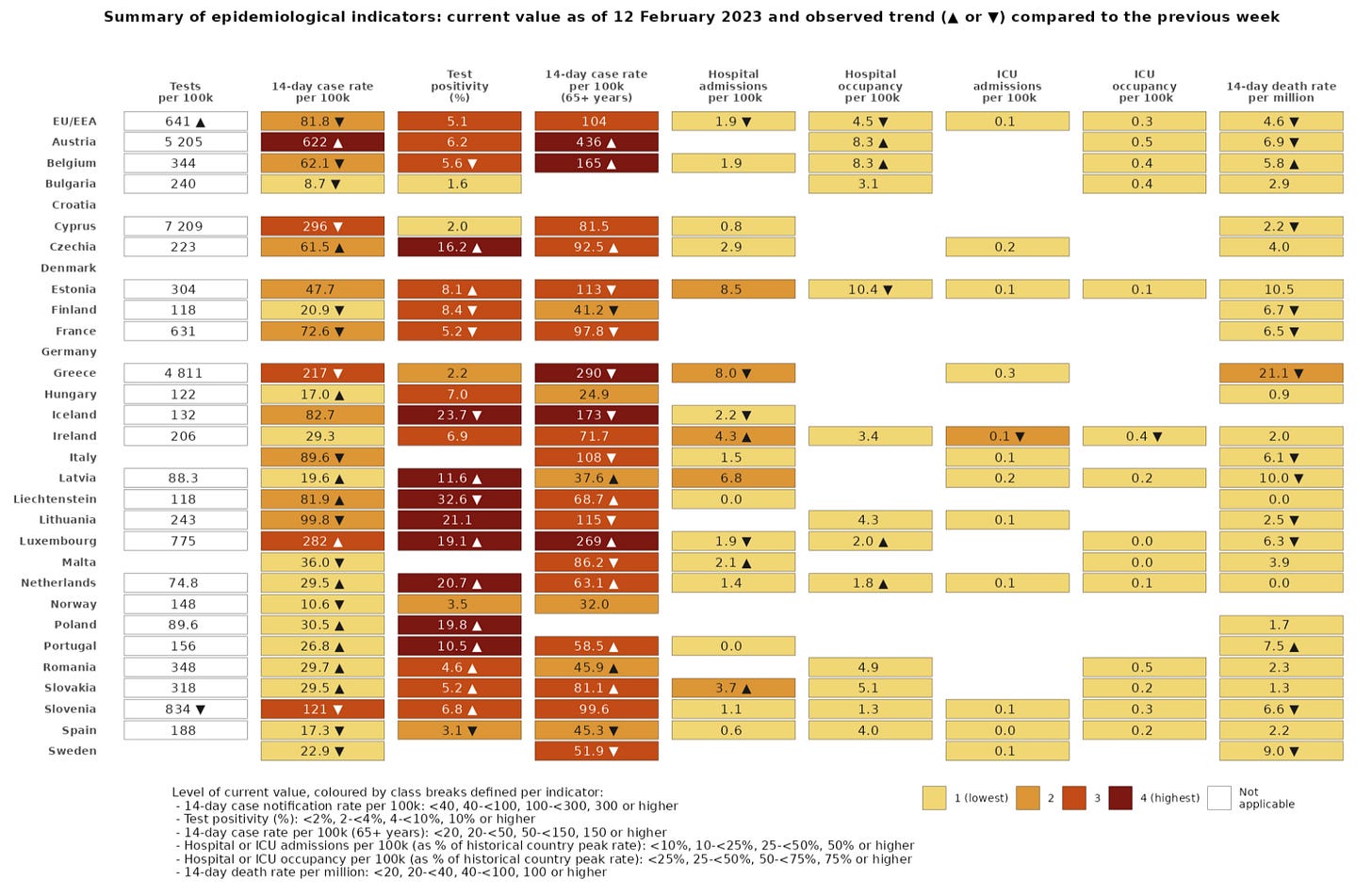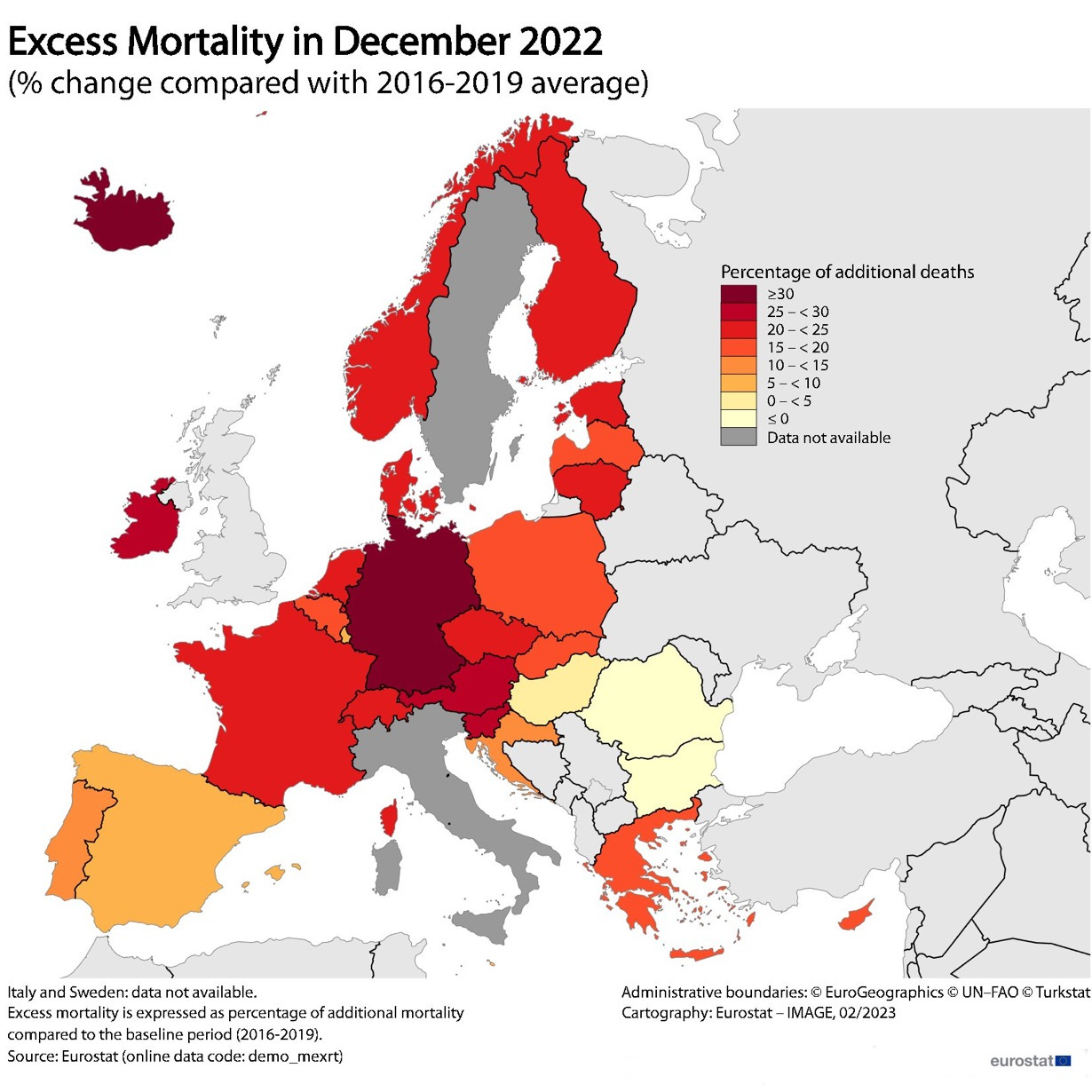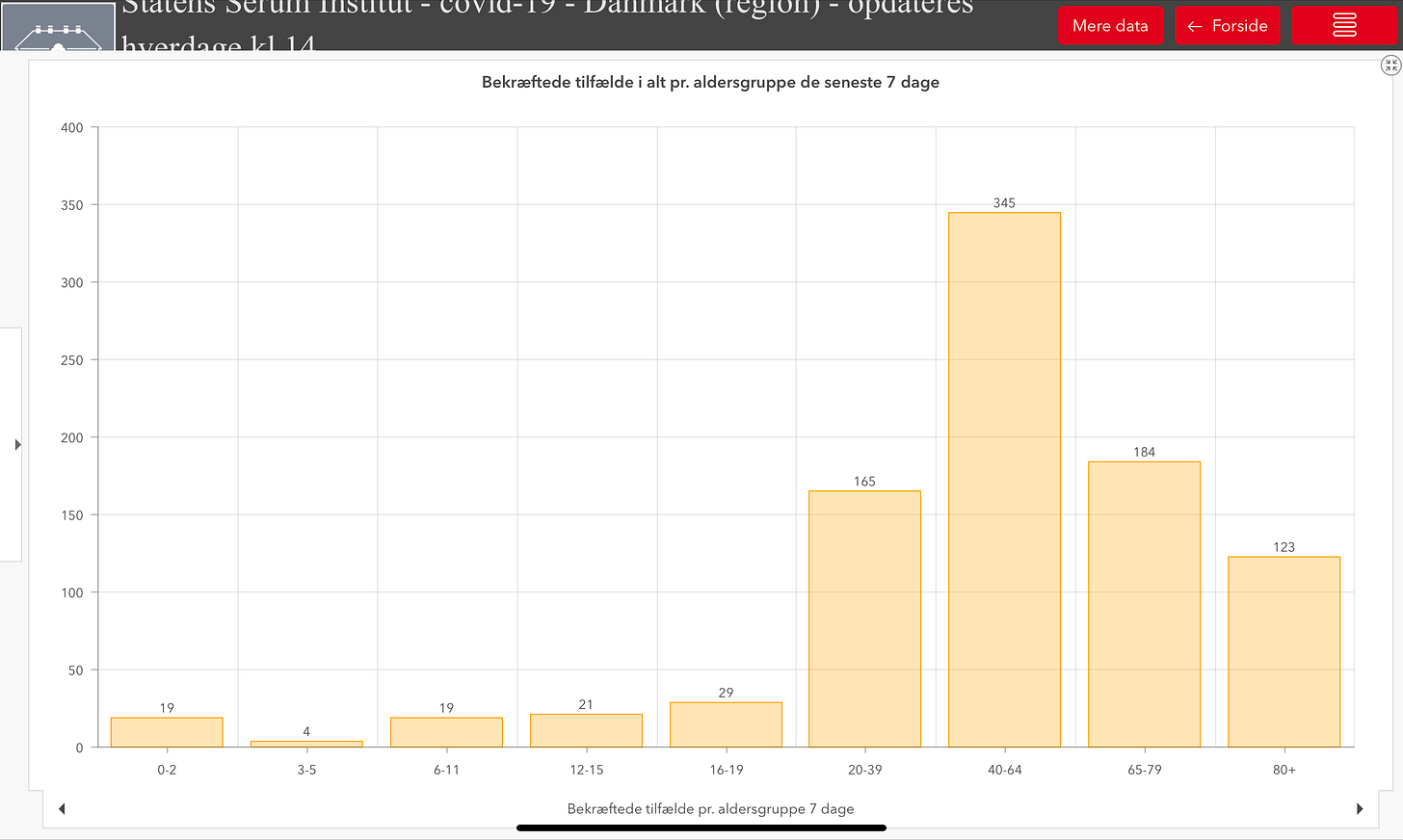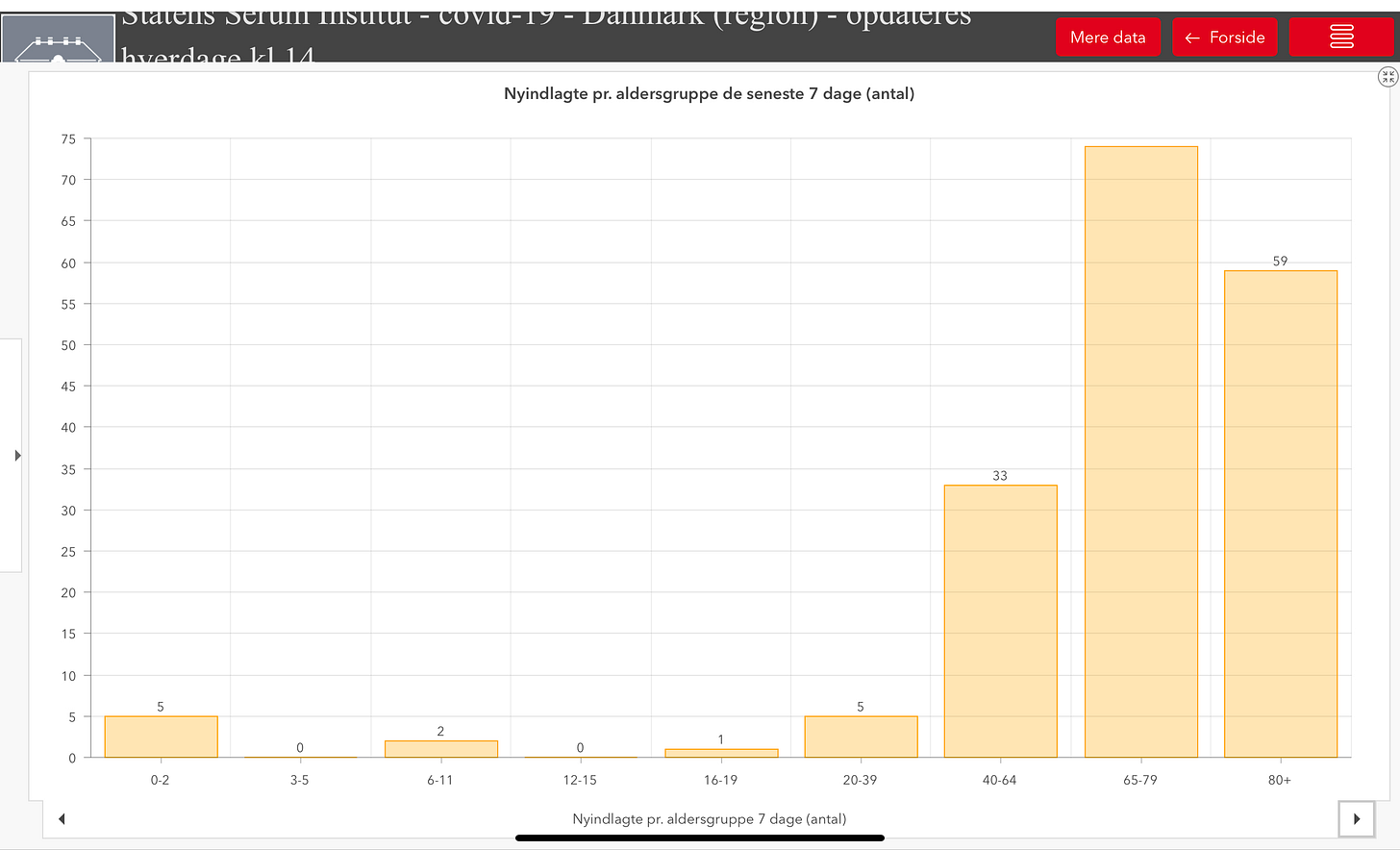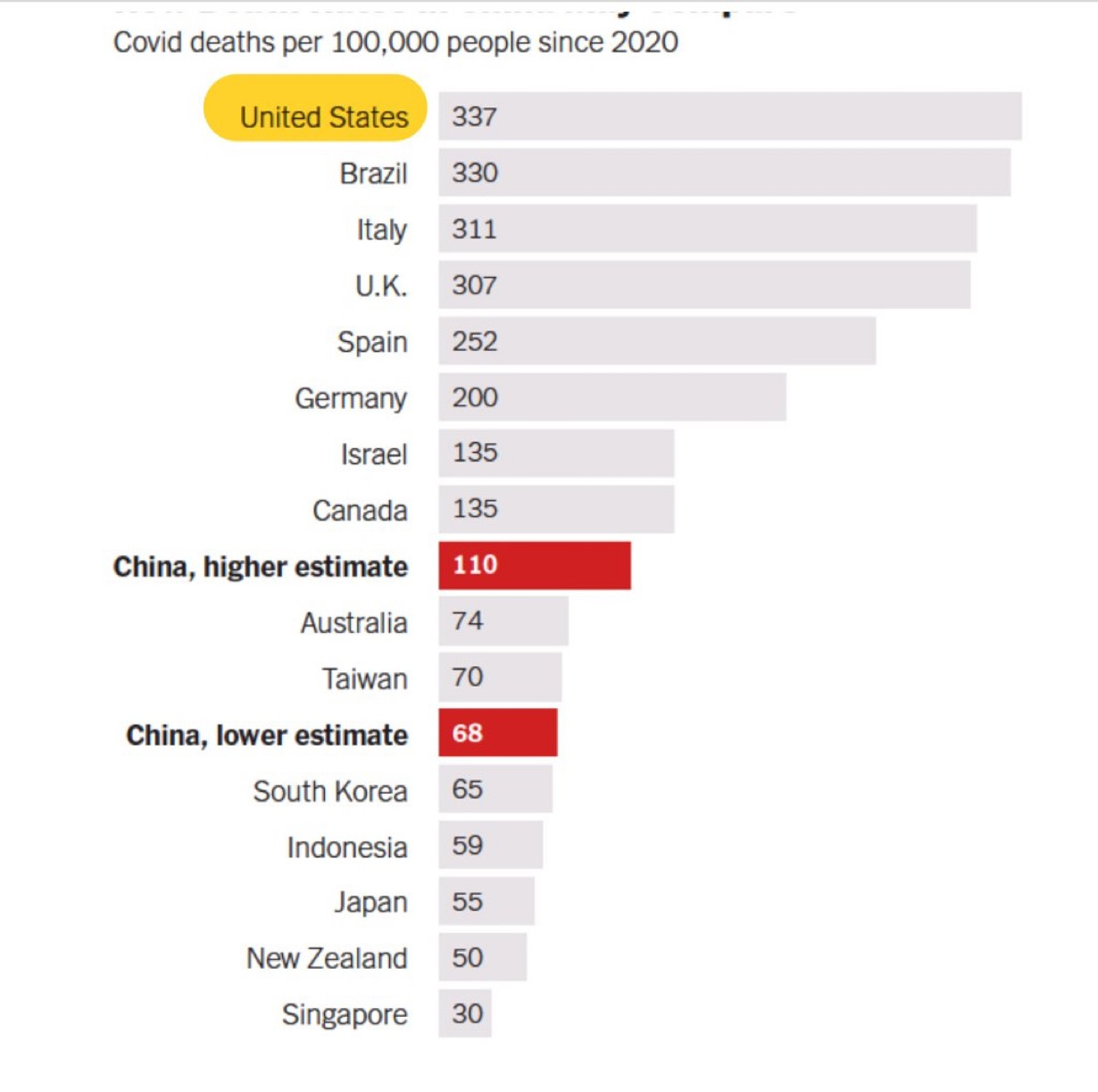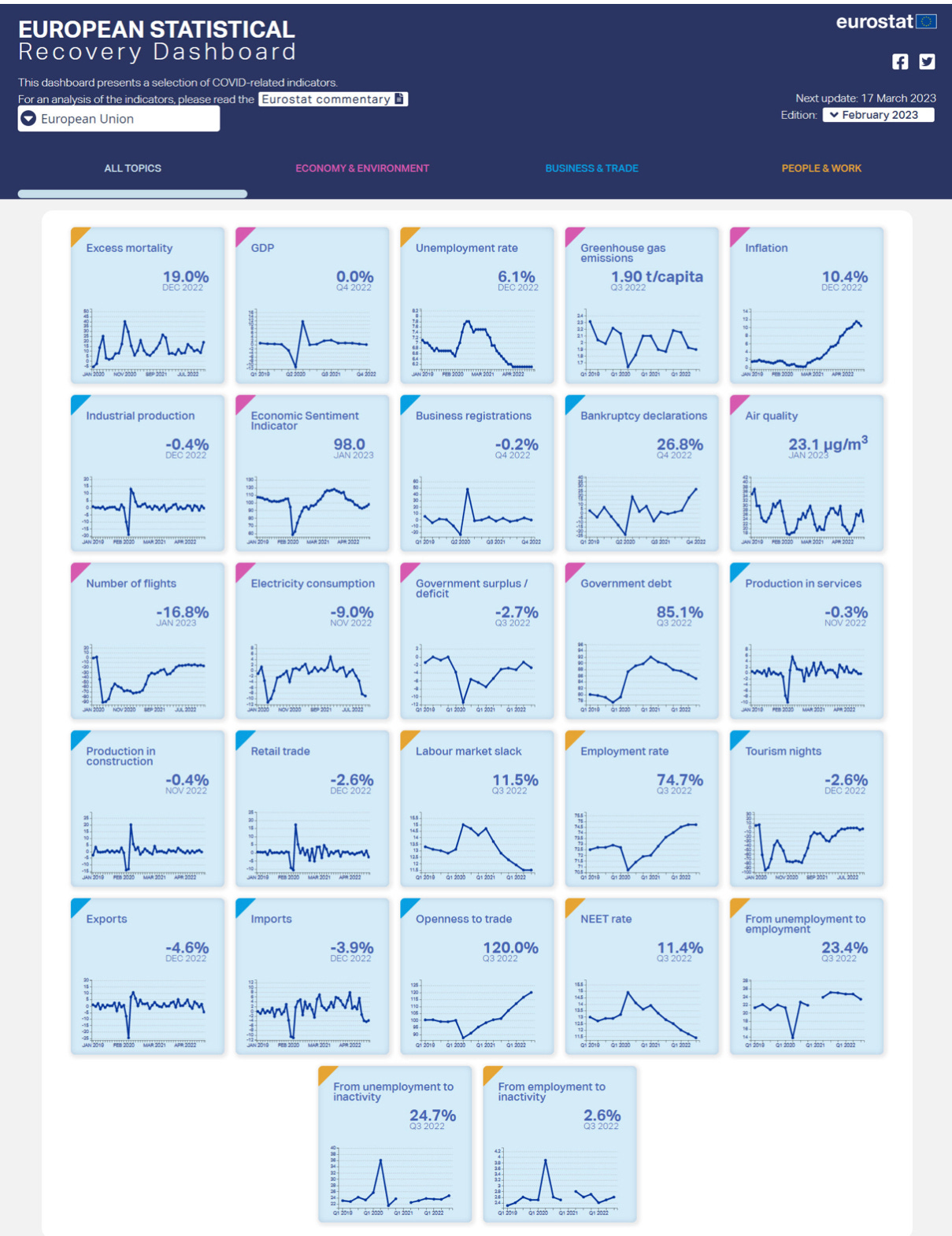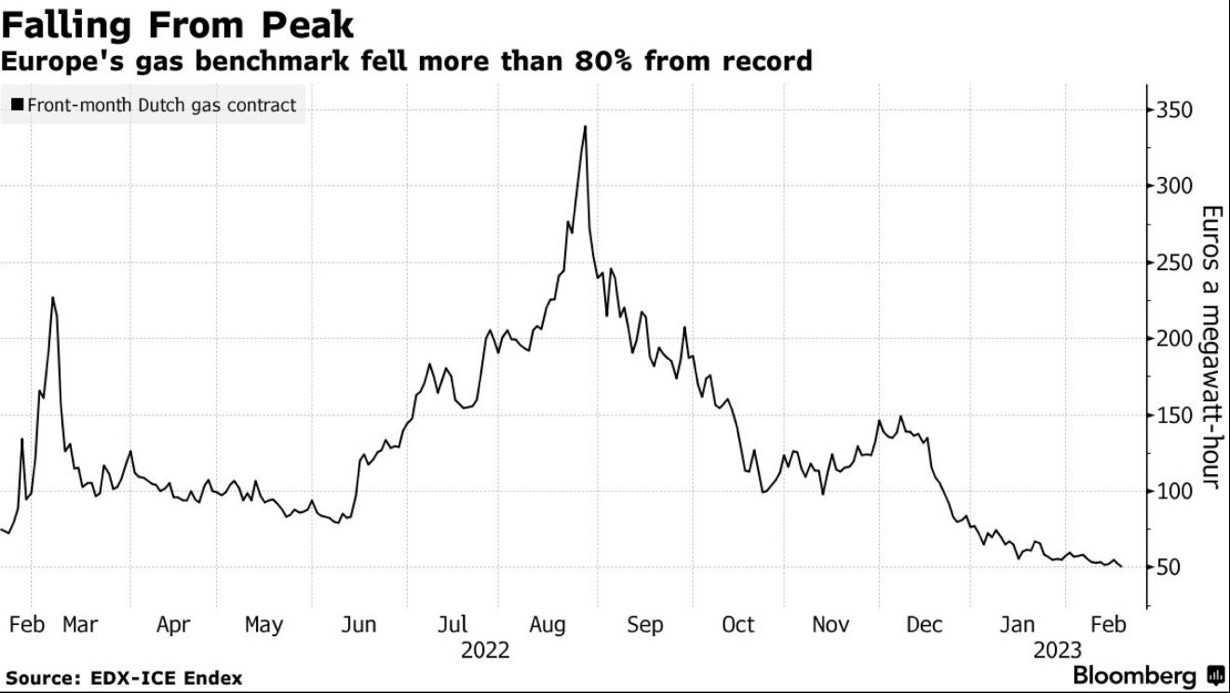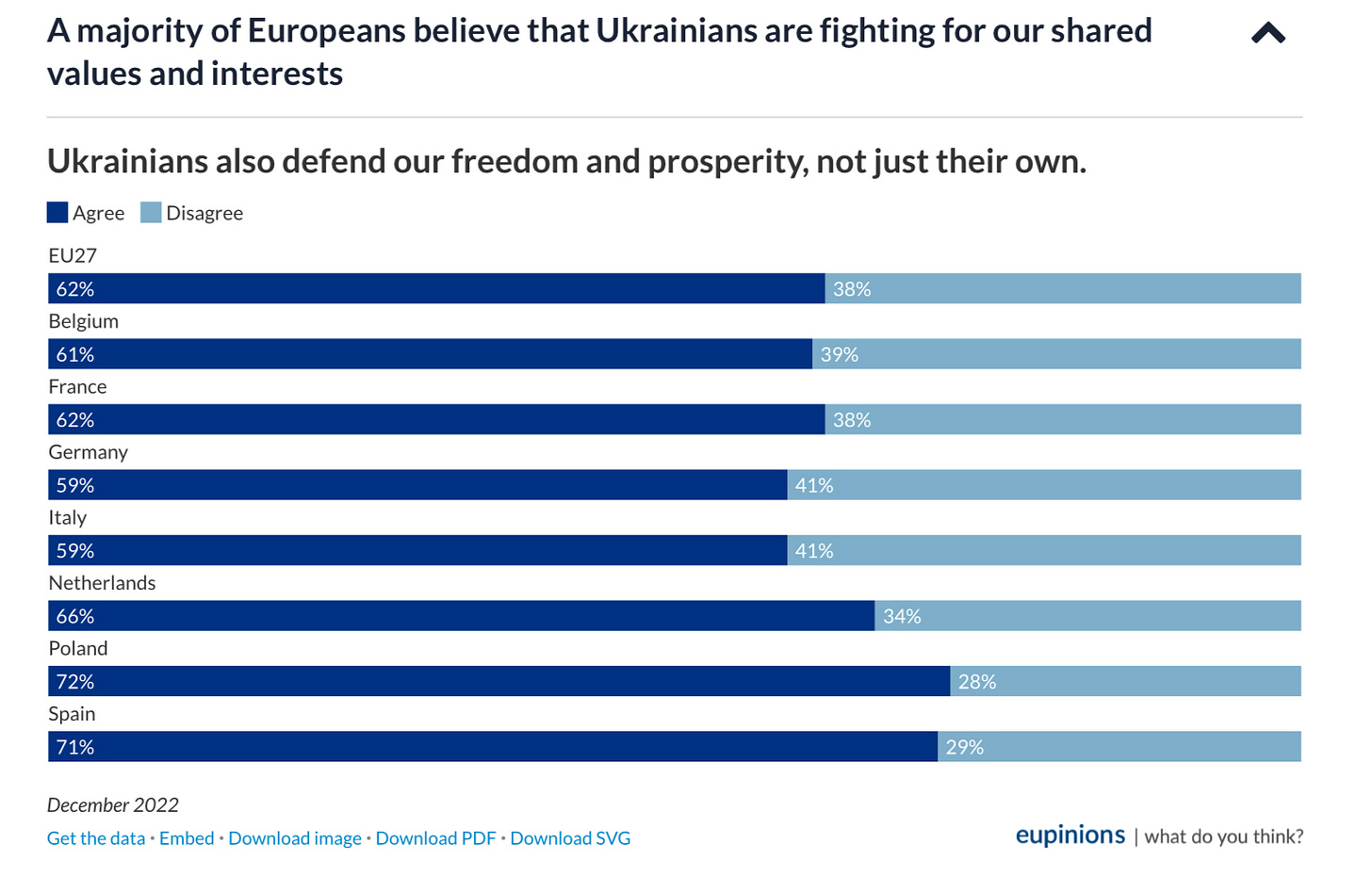🦠Pandemic🦠
🌍 🦠
COVID numbers are falling around the globe, according to the latest weekly pandemic update from the World Health Organization. It says over a 28 day period from January 16 to February 12, there were over 6.7 million new infections (-92%) and over 64,000 coronavirus deaths (-47%).
“Current trends in reported COVID cases are underestimates of the true number of global infections and reinfections. This is partly due to the reduction in testing and delays in reporting in many countries.”
Across the six WHO regions, confirmed infections dropped across the board while two regions, Africa (+22%) and the Eastern Mediterranean (+33%), both saw increasing numbers of COVID deaths for a 2nd straight week. The steepest declines in fatalities were seen in South-East Asia (-60%) followed by the Western Pacific (-58%) and Europe (-50%).
Looking at individual countries, the United States recorded 1,627,259 new infections (-36%), while another 14,326 Americans lost their lives to the virus (+12%). Japan remains a coronavirus concern, with 1,627,259 infections (-61%) and another 8,294 fatalities (-7%). China reported a 98% drop in virus cases (1,272,035) and 20,979 more deaths (-68%). The United Kingdom saw pandemic deaths drop by almost half (2,269 / -47%).
-
The World Health Organization continues to emphasize that COVID testing and sequencing of positive test results are going in the wrong direction. For months it has urged countries to increase their pandemic surveillance but to no avail. The WHO says just 63,113 sequenced tests were submitted to the global virus genome database, GISAID, over the most recent 28-day monitoring period. This means we are more and more blind to new variants and pandemic developments.
The most recent batch of genome sequencing data shows Omicron and its sub-variants continue to dominate around the world. But there are variations in which strains are dominant where. In the Western Pacific, BA.5 rules the roost. But in the Americas, it is XBB.1.5 that dominates. In Europe, BQ.1 is king. The WHO says they just don’t know for the other regions because fewer than 100 sequenced positive tests were submitted.
The global health agency says it continues to keep a sharp eye on specific Omicron sub-variants of concern. They include BF.7, BQ.1, BA.2.75, CH.1.1, XBB, and XBB.1.5.
-
The WHO has added another COVID strain to its variants of concern list and that is XBF. This recombinant strain is a hybrid of BA.5.2.3 and CJ.1 but with a number of additional spike protein mutations. While we don’t know what impact this strain might have, the WHO notes that it has mutations known to increase how contagious a variant might be, and could increase immune escape.
XBF was first identified on July 27, last year. The WHO says it has now been confirmed to be in 46 countries, including Denmark, Sweden, the United Kingdom, Australia, New Zealand, Austria, and the United States of America
“The impact of variants differs by country depending on various factors such as previous immunity and public health and social measures in place. There is currently no reported epidemiological evidence that XBF leads to a rise in cases, hospitalization or deaths.”
🇪🇺🦠
Europe continues to see a vastly improved COVID situation, but there are some warning indicators. The latest weekly pandemic snapshot from the European Centre for Disease Prevention and Control shows infection numbers continue to fall, albeit testing rates make those numbers highly unreliable. The ECDC says hospital admissions, ICU numbers, and the number of coronavirus deaths continues to decline. It says they “currently remain at the lowest levels observed in the past 12 months.”
However, while the overall picture remains positive, there continue to be potential signs of trouble when you zoom down to the individual country level. COVID cases among seniors over 65 are increasing in 10 of 25 countries reporting age-related infection data. Those include Austria, Belgium, Slovakia, and the Netherlands. 11 countries, including the Czech Republic, Latvia, Hungary, and the Netherlands, report rising infection numbers across all age groups. And seven out of 22 countries, including Austria, Belgium, Ireland, and the Netherlands, who report hospitalization data are also seeing rising numbers. The good news is there wasn’t a single country reporting any increases in intensive care capacity.
Across the European Union and the greater European Economic Area, COVID-related hospitalizations and ICU admissions are 12% and 9%, respectively, of the pandemic peak.
Last week, the coronavirus claimed another 658 lives across 25 European countries, reporting fatalities. That is a week-to-week decline of 25.81%.
On the vaccination front, uptake for a second booster dose continues to be lacking in Europe. Just 17.1% of adults over the age of 18 have a 2nd booster dose. That rises to an uninspiring 35.2% for vulnerable seniors over the age of 60.
Getting an even remotely reliable picture of the COVID variant situation in Europe continues to become more difficult. Just seven European countries are testing and sequencing in numbers high enough to derive any useful information from. Of those, BQ.1 was the most active variant coming back in 41.2% of positive sequenced tests. BA.2.75 showed up in 22.5% of infections, while XBB.1.5 made up 14%.
🇪🇺🦠
Excess mortality rates soared in the European Union in December when COVID waves were building to or nearing peaks. Excess mortality is the number of deaths above the average measured over a period of months or years. It has been a useful barometer to get a ‘true’ sense of the pandemic death toll. Other factors might also include RS virus and influenza infection waves.
European Union statistics agency, EuroStat, reports the excess death rate in the EU shot up to +19% in December, the highest rate in all of 2022, and a sharp increase from November’s +8%. Comparatively, excess mortality was +30% in Europe in December 2020 and +24% in December 2021.
Germany recorded the highest excess death rate of any country in the EU (+37%) in December. Trailing behind it was Austria (+27%),
Excess mortality varied across the EU. Lowest rates in 🇷🇴Romania and 🇧🇬Bulgaria (both -6%). Highest rates in 🇩🇪Germany (+37%) and 🇦🇹Austria (+27%), Slovenia (+26%), Ireland, and France (both +25%), and the Czech Republic, the Netherlands, and Estonia (all +23%).
Among the Nordics, Denmark came in the highest (+22.4%), then Finland (+21.1%), and Norway (+21%). Notably, Sweden did not report excess mortality data.
Both Romania and Bulgaria recorded the lowest excess mortality rate (both -6%).
🇩🇰
After three years of being awash in special compensation monies to cover COVID costs and tackle wait lists accrued during the pandemic, one Danish region is beginning the painful process of returning to “normal financial operations.” Region Nordjylland says in 2022 alone, it received over 730 million Danish kroner (just over $141 million Cdn) from the state to cover, among other costs, pandemic impacts.
This year the region could receive at least 80 million Danish kroner in state aid, which includes COVID costs compensation for at least the first quarter of the year.
Regional Council Chair Mads Duedahl says it is time to get back to a financial balance even though he acknowledges hospitals remain under pressure due to the coronavirus. In the region, there are also overcrowding challenges, recruitment issues, and other cost dilemmas.
“We now have less money and it obviously means that we have to reduce consumption and adjust operations so that we can reach a fiscal balance. We can already see that this task is a challenge in our hospitals.”
Complicating things is a major backlog of postponed procedures accrued during the last three years of the pandemic and made worse by last year’s nursing strike.
“It is an enormous cross-pressure, and we have a task to adjust operations sensitively in relation to our staff and at the same time, maintain the high quality of patient care for which we are known.”
The region’s two biggest hospitals, Aalborg University Hospital and Regionshospital Nordjylland, have been tasked with putting together a cost-cutting plan, which will “probably be a larger double-digit million amount.” They have to do this while also, as much as possible, avoiding consequences on patient care. The cost-cutting plans must be tabled by March 20.
-
Over the last seven days, the number of confirmed infections among those 20 to 39 years old and seniors over the age of 65 in Denmark have declined compared to the week previous. But, cases among the 40 to 64 year old age group have increased.
-
92% of all coronavirus-related hospitalizations over the last week have been among age groups of those 40 years old and older. Of those, 74% were seniors over the age of 65
🇸🇪
Sweden’s capital region is taking a hard look at the last three years of the COVID pandemic to see what lessons can be learned to improve healthcare delivery. In Region Stockholm, an investigation has been launched to find improvements and fine-tune best practices. A committee of representatives from the different political parties will run it.
Regional Director Emma Lennartsson:
“After the pandemic, it is clear that Region Stockholm needs to bring about increased collaboration between the different parts of healthcare. This investigation will be an important part of achieving that. In the work, special consideration must be given to the experiences during the pandemic and the work that has already begun to increase production coordination.”
The committee must examine legal avenues, impacts on healthcare capacity, quality of care, and costs, and get the perspective of nurses, including how nursing can be strengthened.
The committee has until May to table an interim report. A final report containing concrete proposals needs to be completed by September.
🇨🇳 🌎 🦠
A New York Times analysis of China’s actual COVID death toll has provided a glimpse of how a number of countries fared during the pandemic and at what cost in human lives. You can read the story in full HERE.
🦠
A meta-analysis study published in The Lancet has found that a coronavirus infection provided substantial protection against reinfection, roughly equivalent to two doses of an mRNA vaccine, for virus strains preceding the Omicron variant. But while protection against infection was much lower once the Omicron BA.1 variant arrived, having a prior infection still afforded very high protection against severe infection resulting in hospitalization or death.
The meta-analysis examined 65 different studies across 19 countries to conclude that infection-related immune protection was very strong (78%) until the Omicron variant arrived (45%). While the protection wall against infection was seriously breached, having had COVID still afforded a person 90% protection, even against Omicron, for up to ten months against severe infection resulting in hospitalization or death.
“The immunity conferred by a past infection should be weighed alongside protection from vaccination when assessing future disease burden from COVID, providing guidance on when individuals should be vaccinated, and designing policies that mandate vaccination for workers or restrict access, on the basis of immune status, to settings where the risk of transmission is high, such as travel and high-occupancy indoor settings.”
According to the study authors, their findings also support putting the appropriate weight on immune protection offered by having had a recent infection. It credits the EU COVID certificate for doing while other countries, like the USA, did not.
While the meta-analysis has been hailed as good news, it is worth noting that the study does not include data from the variant soup of increasingly immune evasive variants since the original Omicron strain.
You can find the study in full HERE.
⚡️Energy Crisis⚡️
🇪🇺
The pandemic recovery continues to be a mixed bag in the European Union, according to the largest assessment from the EU statistical agency, EuroStat. It says the European economy showed zero growth in the 4th quarter, narrowly dodging a recession. Inflation in Europe also continued to drop thanks to falling energy prices
“As a result of high energy prices and EU-coordinated actions to curb electricity consumption, European electricity use has fallen to levels not seen since COVID lockdowns depressed demand in April and May of 2020.”
EU electricity consumption was 9.0% lower in November 2023 compared to the same month in each of the four years preceding the pandemic.
And while the labour market continued to perform strongly and unemployment remained stable, below pre-pandemic levels, there were some troubling developments. Bankruptcy declarations in the EU “continued to accelerate” and have risen above pre-pandemic levels. Industrial production and retail trade also fell in December, usually a strong month for both.
-
For the first time in 17 months, European natural gas futures dropped below €50 as Europe looks like it might escape this winter’s energy crisis more or less unscathed. The news is good, but it is worth emphasizing that Europe’s energy concerns are far from over. The warmest winter on record has bought us a reprieve until next winter.
🇺🇦/ 🇷🇺 War
🇫🇮 🇸🇪/ 🇹🇷
It is in Turkey’s hands now. That is what Finland’s President Sauli Niinisto had to say on Friday about Finland and Sweden’s NATO applications. Turkey and Hungary are the last two member nations of the 30 that make up the military alliance that have yet to hold a ratification vote.
“Finland and Sweden have expressed their will and applied to join NATO. That is our expression of will. Türkiye’s attitude to this will of ours is solely and exclusively in Türkiye’s hands. We continue to have a common understanding with Sweden: both as members as soon as possible. Türkiye has its own understanding of the situation and the way forward. And as I said, it's entirely in Türkiye’s hands. We do not want to and cannot withdraw our application. We have expressed our will.”
But Finnish Prime Minister Sanna Marin continued reiterating that they are pursuing NATO membership in lockstep with Sweden.
“Finland has made this wish clear to Turkey and Hungary.”
Later in the weekend, Finnish Foreign Affairs Minister Pekka Haavisto confirmed that Turkey has officially communicated to Finland that it has fulfilled the terms of the tripartite agreement reached in Madrid. This would seem to greenlight Turkish support for Finland to join NATO. It also narrows Turkish opposition to its issues with Sweden.
Finnish President Sauli Niinistö was quick to add that it is Finland’s view that Sweden has also fulfilled its obligations under the tripartite agreement.
“We have done everything that can be expected of Finland in terms of NATO membership by submitting a NATO application. Sweden has done the same.”
🇸🇪/ NATO
The Prime Minister of Sweden warns against admitting Finland to NATO without Sweden.
Ulf Kristersson spoke to the Financial Times:
“It will be bad for Sweden, bad for Europe, bad for NATO, and for Sweden's ability to provide security together with Finland, at the same time as we have a war in here in Europe.”
Kristersson added that he believes that military cooperation between Finland and Sweden, two slowly allied countries, will be “complicated” should Finland join NATO without Sweden.
Turkey has used the situation as leverage to gain concessions from the two Nordic nations. But, frustrations over Swedish courts blocking Turkey’s extradition requests and the burning of a Quran in Stockholm have ignited a much stronger Turkish opposition to Sweden.
🇫🇮/ NATO
Although Hungary and Turkey still have not scheduled a ratification vote on Finland and Sweden’s NATO applications, the Finnish parliament is charging ahead. A Finnish parliamentary Foreign Affairs committee has recommended parliamentarians approve NATO membership. The Finnish parliament will consider the report this week with a vote scheduled for February 28. A simple majority will decide the vote. This would effectively lock in Parliamentary approval for Finland to join NATO even though two of the 30 NATO member nations have yet to hold a vote to say yes or no. Finland and Sweden need a yes from all 30 countries to become full NATO members.
The committee’s report concluded that joining NATO, would deter future security threats to Finland. It also put an estimated €70 to €100 million annual costs to become a part of the military alliance.
🇫🇮/ 🇺🇦
Finnish Defense Minister Mikko Savola has confirmed that Finland will donate Leopard tanks to Ukraine as it joins the coalition of countries sending more modern tanks to join the war against Russia.
Poland and Germany are both working to put together tank shipments to Ukraine. The relationship between the two countries has become a little strained during the push to free the Leopards for Ukraine. Germany is assembling a battalion of Leopard 2 A6 tanks for Ukraine, while Poland is putting together a shipment of Leopard A4 tanks. Finland reportedly has both in its inventories.
Savola says Finland will likely also contribute a battalion of Leopard tanks, but it was unclear whether it was on Team Poland or Team Germany, or which of the two tank models it would donate, or if it would be a battalion of each.
"In principle, we can be involved with both. There will be a decision on that very soon. We will participate with our own contribution, also in a way that satisfies Germany."
Germany had pledged that Ukraine would get over 100 newer Leopard tanks, but some cracks in the tank coalition may have knocked those numbers down a bit
-
Finland is working to put together its 13th weapons package for Ukraine. In the past, Finland has been extremely tight-lipped about the specific contents of the weapons packages it sends Ukraine. It usually announces a package is on its way, and no further details are ever revealed. That practice may be over, according to Finnish Defense Minister Mikko Savola. He says Finland’s conservative tact to information sharing is creating confusion, and the public could soon get more details on weapons going from Finland to Ukraine.
"The next package will also be significant. Anti-aircraft systems, ammunition, and heavy weaponry, in general, are what they need.”
While tanks and fighter jets dominate talks, Savola says Ukraine is desperate for anti-aircraft systems. Politico reports that Finland has reached a deal with Israel to acquire anti-aircraft systems.
🇩🇰 🇲🇩/ 🇷🇺
European leaders attended a security conference in Munich over the weekend. Danish Prime Minister Mette Frederiksen was there and warned that if Russia is not stopped in Ukraine, its war machine will move on to more countries. Frederiksen specifically mentioned Moldova, where the country’s government warned that Russia is planning a coup.
“Moldova may be the next country on Putin's list, and I do not feel sure that he will stop with Ukraine. Moldova is a very poor small European country that is the target of a very large influence campaign from the Russians, which threatens to actually undermine the country's cohesion. We have a clear interest in keeping Moldova as close to Europe as possible. It is a poor country, and there is no way around it but also to support them financially.”
🇩🇰/ 🇺🇦
The argument over whether to supply Ukraine with more modern fighter jets continues across Europe. In Denmark, Foreign Affairs Minister Lars Løkke Rasmussen told Berlingske he is all for getting Ukraine the jets they need.
“If you ask me as foreign minister if the free world is going to deliver planes to Ukraine, then I definitely think that it is within the expected starting point that it will happen in the coming time. It is not a decision that someone is about to make here and now, but I have no doubt that this war is at a very, very critical time with an imminent Russian offensive.”
-
As we approach the one-year anniversary of Russia’s invasion of Ukraine, Denmark’s Salling Group is launching an aid effort across its chain of grocery stores. As of today, a special Ukraine cake is on sale at Fotex and Bilka. For the next two weeks, 10 Danish kroner from every cake sold will go to Folkekirkens Church Aid’s efforts in Ukraine. This includes support for refugee centers, money to purchase generators, help in demining, and a legal fund for Ukrainians who have been victims of war crimes.
Also today, the Ukrainian flag will be raised at Bilka and Fotex stores and at Salling Group headquarters in Årslev.
Netto in Poland, also a part of the Salling Group, has been active in raising donations and offers discount prices to Ukrainians who have fled to Poland.
In Denmark, Salling Group grocery stores removed Russian goods from their shelves within the first week of the Russian invasion. It has also undertaken an effort to make sure that Russian gas is not used in heating its stores.
HR Director Louise Gade:
“We don't imagine that we can change the lives of everyone in war and who is in need, but everyone can help someone, and that also applies to us. That is why we are proud of the partnership with Folkekirkens Nødhjælp, both in everyday life, in the fight against food waste, but in particular when it comes to helping the world's needy.”
🇩🇰/ 🇷🇺
The Queen of Denmark is causing quite a reaction by speaking her mind about a head of state she finds to be particularly distasteful. In an interview with Weekendavisen, Queen Margrethe II describes Russian President Vladimir Putin in a that breaks with royal tradition.
“I remember thinking he was not pleasant. I have never seen such cold eyes in my life.”
The Queen has met Putin several times.
She also praised Ukrainian President Volodymyr Zelenskyy and how Ukraine needs newer Leopard tanks.
“They [the Ukrainians] need something heavy. And they also show that they can use it. It is deeply impressive. Putin thought he could tear the whole of Europe apart, but he made us stand together.”
Danish Foreign Affairs Minister, and former Prime Minister, Lars Løkke Rasmussen said the Queen’s description of Putin rings true in his eyes. He attended one of the meetings between the Queen and Putin, telling DR it wasn’t enjoyable.
“Not the most cordial visit I have participated in, with a head of state at Amalienborg. That the queen has that perception of Putin, I can both confirm that she has had for a long time, and I also can’t disagree personally.”
🇭🇺/ 🇪🇺 🇷🇺
Europe continues to struggle with the dictator in its midst. Hungarian Prime Minister Viktor Orbán, who continues to cozy up to Russia, said in an address to the nation that Europe is indirectly at war with Russia.
“Europe is currently drifting into war with Russia. They are walking a dangerous balancing act. It started with helmets, and now we are sending tanks, and fighter jets are on the agenda, and soon we will hear about so-called peacekeeping troops.”
Hungary, also a member of NATO, has signed energy deals with Russia despite European sanctions and has refused to supply Ukraine with weapons. The Orbán government has even blocked EU funding from going to Ukraine.
🇫🇷/ 🇷🇺 🇺🇦
At the Munich security conference, French President Emmanuel Macron said he is preparing for a long protracted war in Ukraine. Macron also added that he doesn’t think the time is right for any dialogue with Russia, although peace talks could begin later. He says that while Russia must lose in Ukraine, he was not in favour of taking the conflict any further to “crush” Russia.
Macron spoke to Le Journal du Dimanche:
“I do not think, as some people do, that we should aim for a total defeat for Russia and attack Russia on its own soil.”
🇪🇺/ 🇺🇦 🇷🇺
Europeans remain strongly supportive of Ukraine in its war with Russia. A majority also believe that Ukrainians are fighting for European values and a way of life. A poll by EUpinions found that 61% of Europeans think Ukraine will win the war. But 68% are getting anxious and see the attack on Ukraine as an attack on all of Europe.
EUpinions Head Isabell Hoffmann:
“This unity is an important signal. Common values are a cornerstone of the support provided to Ukraine by the EU and its member states. The longer this war drags on, the more important it is for Ukrainians to know that the majority of EU citizens acknowledge their achievements.”
66% of respondents also reveal they are growing worried, noting that Russia’s invasion of Ukraine has made the world a much more dangerous place.
“The level of anxiety is exceptionally high right now. Given the brutality of the war, the toll it’s taking, and the overall threat level, this is not surprising. What’s really remarkable, however, is that the most anxious are just as supportive of Ukraine as are EU citizens as a whole.”
The one issue in the poll where opinions seemed to splinter was the effectiveness of sanctions against Russia. 40% say sanctions are effective. 40% believe they are ineffective, and 20% are undecided.




